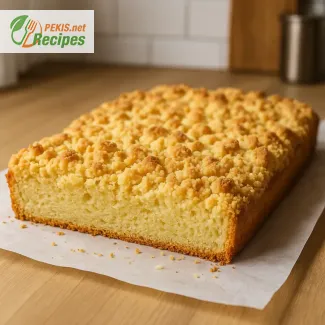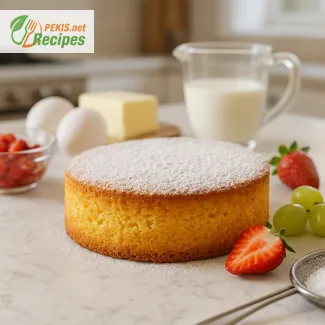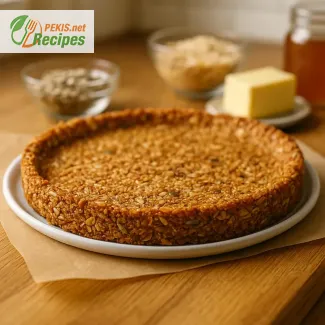
Discover the Authentic Taste of Thuringia's Famous Crumble Cake
A beloved German pastry tradition perfect for sunny summer afternoons
Among the many regional specialties Germany has to offer, Thuringian Crumble Cake stands out as one of the most cherished and timeless. Known in its native language as Thüringer Streuselkuchen, this classic German crumb cake has earned its reputation not only through its comforting, rustic flavors but also thanks to its unique texture and versatility. Whether enjoyed with a cup of coffee in a traditional German café or baked at home for a family gathering, this dessert continues to be a seasonal favorite, especially during the warmer months.
What makes the Thuringian Crumble Cake so special is its perfectly balanced combination of a tender yeast or sponge base and a generous layer of golden, buttery streusel topping. These buttery crumbles provide a satisfying crunch that contrasts with the soft interior, resulting in a pastry that’s both rich and delicate. Traditionally baked on a large tray, this cake is designed to be sliced into squares and shared, making it ideal for garden parties, Sunday brunches, or festive celebrations.
The origin and legacy of Thuringian baking culture
Why Thuringia’s regional recipes continue to captivate modern bakers
The region of Thuringia, located in the heart of Germany, has long been known for its contributions to both savory and sweet culinary traditions. From bratwurst to bread, the area’s approach to food is rooted in simplicity, quality, and regional pride. The Streuselkuchen, with its humble ingredients and nostalgic taste, reflects these values perfectly.
Historically, this German crumb cake was baked in wood-fired ovens and often flavored with regional fruits such as plums, sour cherries, or rhubarb, depending on the season. While today’s variations may include modern twists—such as adding vanilla custard, marzipan, or even chocolate chips—the traditional Thuringian version remains faithful to its roots: a soft base, a thick streusel layer, and occasionally a light dusting of powdered sugar once cooled.
Perfect pairing for summer: how Thuringian Crumble Cake complements seasonal flavors
Serving suggestions and traditional German accompaniments
What truly elevates the Thuringian Crumble Cake is its compatibility with summer’s bounty. Its mild sweetness makes it an excellent pairing for fresh berries, whipped cream, or a scoop of vanilla ice cream. In Thuringian homes, it’s not uncommon to serve this cake with a dollop of sour cream or a drizzle of fruit compote, further enhancing its fruity character.
Because of its large baking format and ability to feed many guests, this cake often finds its way onto picnic tables, wedding buffets, and summer festivals throughout the region. When served slightly warm and accompanied by a chilled coffee or light white wine, it becomes more than just dessert—it’s a reflection of hospitality, tradition, and seasonal indulgence.
The texture and technique that define the perfect Streuselkuchen
What sets Thuringian-style crumble apart from other crumb cakes
While crumble cakes are found in many cultures, the German Streuselkuchen—especially the Thuringian variation—has a distinctive character. Unlike American-style crumb cakes that typically use baking powder and dense batters, Thuringian cakes often rely on yeast dough or a soft sponge base to give them a lighter, airier texture.
The streusel topping, made from a simple mix of butter, sugar, and flour, is not just sprinkled but pressed into chunky pieces that form crispy golden clusters during baking. These crumbs are not overly sweet, allowing the natural flavor of the butter and any underlying fruit to shine. Bakers often use cold butter and avoid overmixing to maintain the coarse texture that defines an authentic German streusel.
Why this German summer cake continues to thrive across borders
From traditional Thuringian homes to modern international kitchens
In recent years, the Thuringian Crumble Cake has gained popularity beyond Germany, becoming a featured dessert in international cafés and bakeries. Its rustic charm, nostalgic flavor profile, and visual appeal have made it a favorite among pastry lovers seeking authentic European baked goods.
As more people look to revive heritage recipes and incorporate traditional flavors into their kitchens, this German summer crumb cake offers a perfect introduction to regional baking. It’s approachable, visually inviting, and adaptable to a variety of seasonal ingredients. Whether baked for a holiday celebration or simply shared over coffee on a summer afternoon, the Thuringian Streuselkuchen promises to bring warmth, texture, and time-honored flavor to the table.
- Prepare the yeast dough: Warm the milk (not hot) and dissolve the active dry yeast and sugar in it. Let it sit for 10 minutes until foamy. In a large mixing bowl, combine flour and salt. Add the softened butter, egg, lemon zest, and yeast mixture. Knead the dough by hand or with a mixer for 8–10 minutes until smooth and elastic. Cover and let rise in a warm place for 45–60 minutes until doubled in size.
- Prepare the streusel topping: In a separate bowl, combine flour, sugar, vanilla sugar, and cinnamon. Add cold cubed butter and rub the mixture with your fingers or a pastry cutter until coarse crumbs form. Place the bowl in the refrigerator to chill while the dough rises.
- Assemble the cake: Preheat the oven to 180 °C (350 °F). Line a rectangular baking tray (approx. 30×40 cm / 12×16 inch) with parchment paper. Roll out the dough evenly and transfer it to the tray. If using fruit, spread it evenly on the dough. Sprinkle the streusel topping generously across the surface.
- Bake: Place the cake in the middle rack and bake for about 35 minutes, until the streusel is golden brown and crisp. Let cool completely before slicing. Optional: dust with powdered sugar before serving.
Enhance Your Crumble Game: Creative Twists on the Classic German Cake
Expert insights and modern tips to elevate your Thuringian baking experience
While the Thuringian Crumble Cake is beloved for its simplicity and rustic charm, there's plenty of room for creative improvement without straying far from tradition. Whether you're looking to refine the texture, balance the sweetness, or introduce new flavors, small adjustments can make a significant difference. Understanding the science behind each component allows you to experiment with confidence and craft a version that reflects your personal taste or dietary needs.
Ingredient upgrades that enrich flavor and texture
How to customize the base, filling, and streusel for a richer experience
The yeast dough is the backbone of this cake, and although it's often made with basic all-purpose flour, switching to spelt flour or a blend of whole wheat and white flour can add a nutty depth while improving the nutritional profile. If using whole grain flours, be sure to increase the liquid slightly to maintain softness.
For the streusel topping, replacing part of the butter with brown butter adds a rich, nutty flavor that enhances the complexity of the cake. You can also incorporate chopped nuts like hazelnuts, almonds, or pecans into the streusel for extra crunch and a roasted aroma.
If you're using fruit, opt for seasonal and ripe produce. Fresh apricots, blueberries, or thinly sliced apples work exceptionally well and each brings its own natural sweetness and acidity. Adding a thin layer of vanilla custard or cream cheese filling between the dough and the streusel can also create a luscious, layered dessert that feels more indulgent.
Common mistakes and how to avoid them
Small details that affect consistency, taste, and baking success
One of the most frequent errors is using warm or soft butter in the streusel. This can cause the crumble to lose its characteristic texture and melt into the cake during baking. Always use cold, cubed butter and avoid overmixing—streusel should remain crumbly and coarse.
Another pitfall is underproofing or overproofing the yeast dough. If the dough hasn't risen enough, it will be dense and chewy. If overproofed, it might collapse during baking. Allow the dough to double in size at room temperature without rushing the process.
Additionally, ensure even distribution of streusel over the surface. Sparse areas will bake unevenly and result in dry patches. It helps to gently press the crumbles into the dough so they don’t slide off during baking.
Health-conscious substitutions that maintain taste
How to make the cake lighter or suitable for special diets
To reduce sugar content without compromising flavor, you can substitute part of the sugar in both the dough and the topping with coconut sugar or maple syrup. These alternatives offer a lower glycemic index and a more nuanced sweetness.
For a dairy-free version, use plant-based milk such as almond, soy, or oat milk, and replace the butter with vegan margarine or cold-pressed coconut oil. To keep the crumble crispy, choose a fat that remains solid at room temperature.
To lower saturated fat, consider using Greek yogurt in the dough, replacing part of the butter or milk. This adds moisture and slight tang while also boosting protein content. You can also reduce cholesterol by replacing the egg with a flaxseed or chia seed egg substitute.
Why homemade always tastes better
The role of freshness, control, and craftsmanship in baking
A homemade Thuringian Crumble Cake offers unparalleled freshness. The streusel stays crisp, the dough retains its elasticity, and the flavors are vibrant and well-balanced. You have full control over ingredient quality, allowing you to choose organic flour, real vanilla, or seasonal fruit without compromise.
Moreover, making the cake yourself lets you fine-tune it for the occasion—light and fruity for summer afternoons, rich and buttery for festive gatherings. Unlike store-bought versions, which often use preservatives or margarine, your homemade cake reflects authentic ingredients and care.
Small changes, big impact
Expert-level tricks for a bakery-quality finish
To enhance visual appeal, brush the edges of the dough with egg wash before baking for a golden sheen. Add a dusting of powdered sugar or a drizzle of lemon glaze after baking to brighten the flavor. For extra texture, sprinkle a few rolled oats or seeds into the streusel.
Baking on a preheated stone or steel tray can improve bottom crispness, especially for fruit-filled versions. For longer freshness, store the cake in an airtight container at room temperature for up to two days, or freeze individual slices for a quick treat later.
Finally, don't be afraid to play with spices: a pinch of cardamom, nutmeg, or ginger in the streusel can transform the cake into a seasonal delight, tailored perfectly to your preferences.
Allergens present in the recipe:
- Gluten (from flour)
- Eggs
- Milk (from butter and milk)
Suggestions for allergen replacements:
- For gluten-free version: use gluten-free all-purpose flour and add 1 tsp xanthan gum to the dough.
- For dairy-free version: replace milk with almond or oat milk, and butter with vegan margarine.
- For egg-free version: use 60 ml (¼ cup) unsweetened applesauce or 1 tbsp ground flaxseed mixed with 3 tbsp water.
Vitamins and minerals per serving (approximate):
- Vitamin B1 (Thiamine): 0.25 mg – supports energy metabolism and nervous system
- Calcium: 55 mg – essential for bone strength and muscle function
- Iron: 2.2 mg – contributes to oxygen transport in the blood
- Magnesium: 30 mg – aids in muscle function and heart rhythm regulation
- Phosphorus: 100 mg – supports healthy bones and teeth
Antioxidants per serving (approximate):
- Polyphenols: 90 mg – protect cells from oxidative stress
- Beta-carotene (if fruit used): 0.3 mg – supports skin and eye health
- Flavonoids (from cinnamon and fruit): 25 mg – may reduce inflammation and promote heart health





